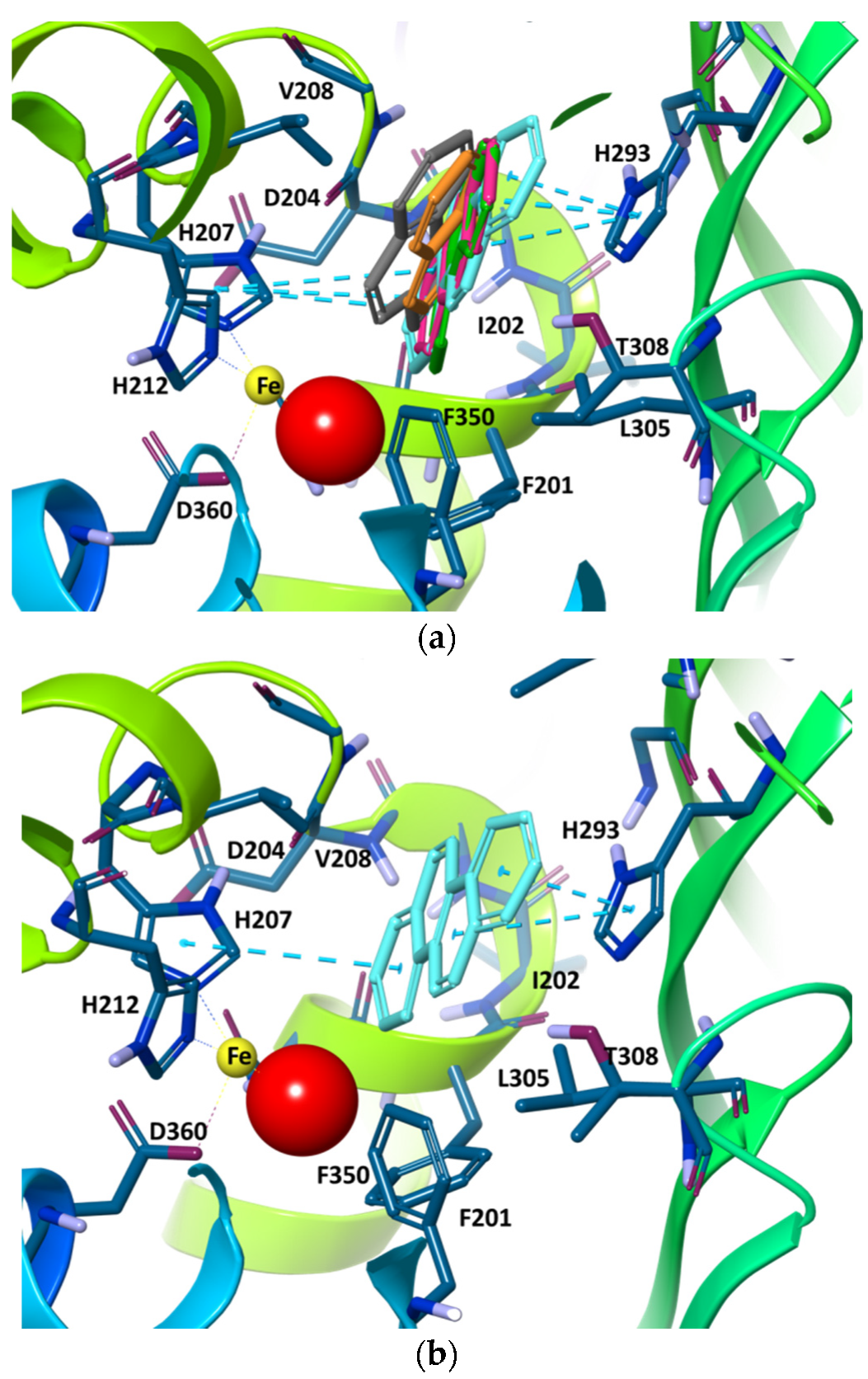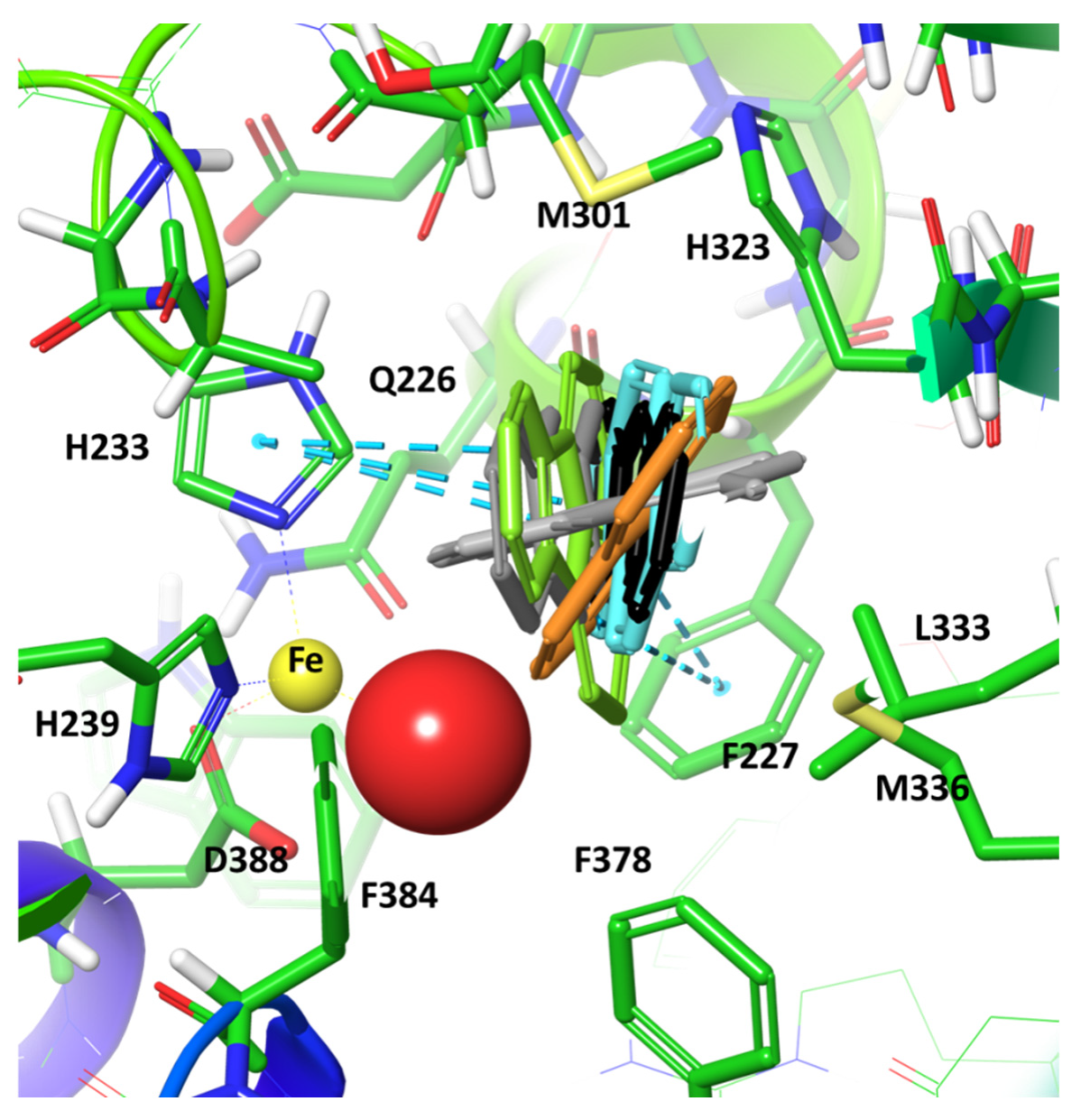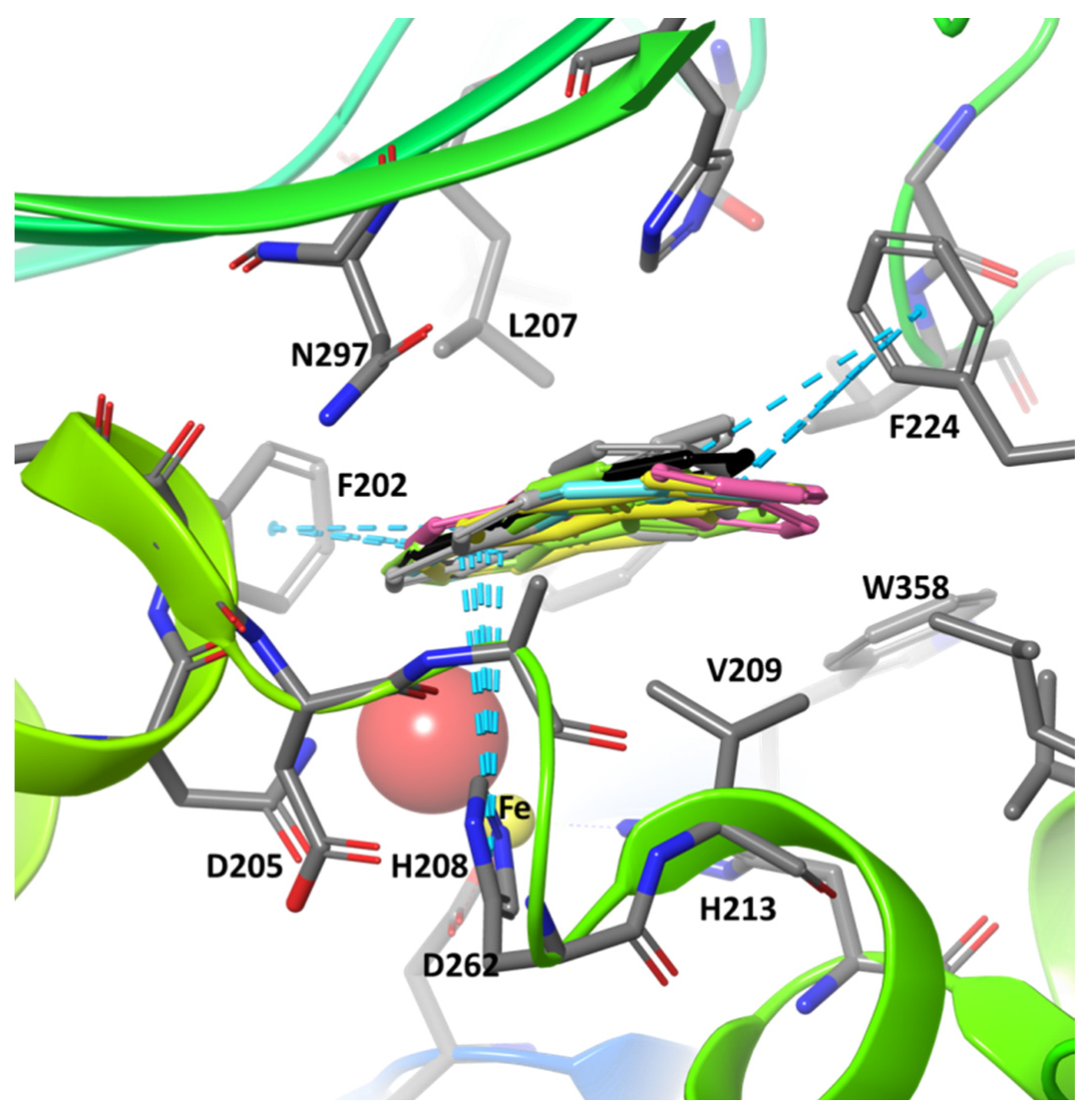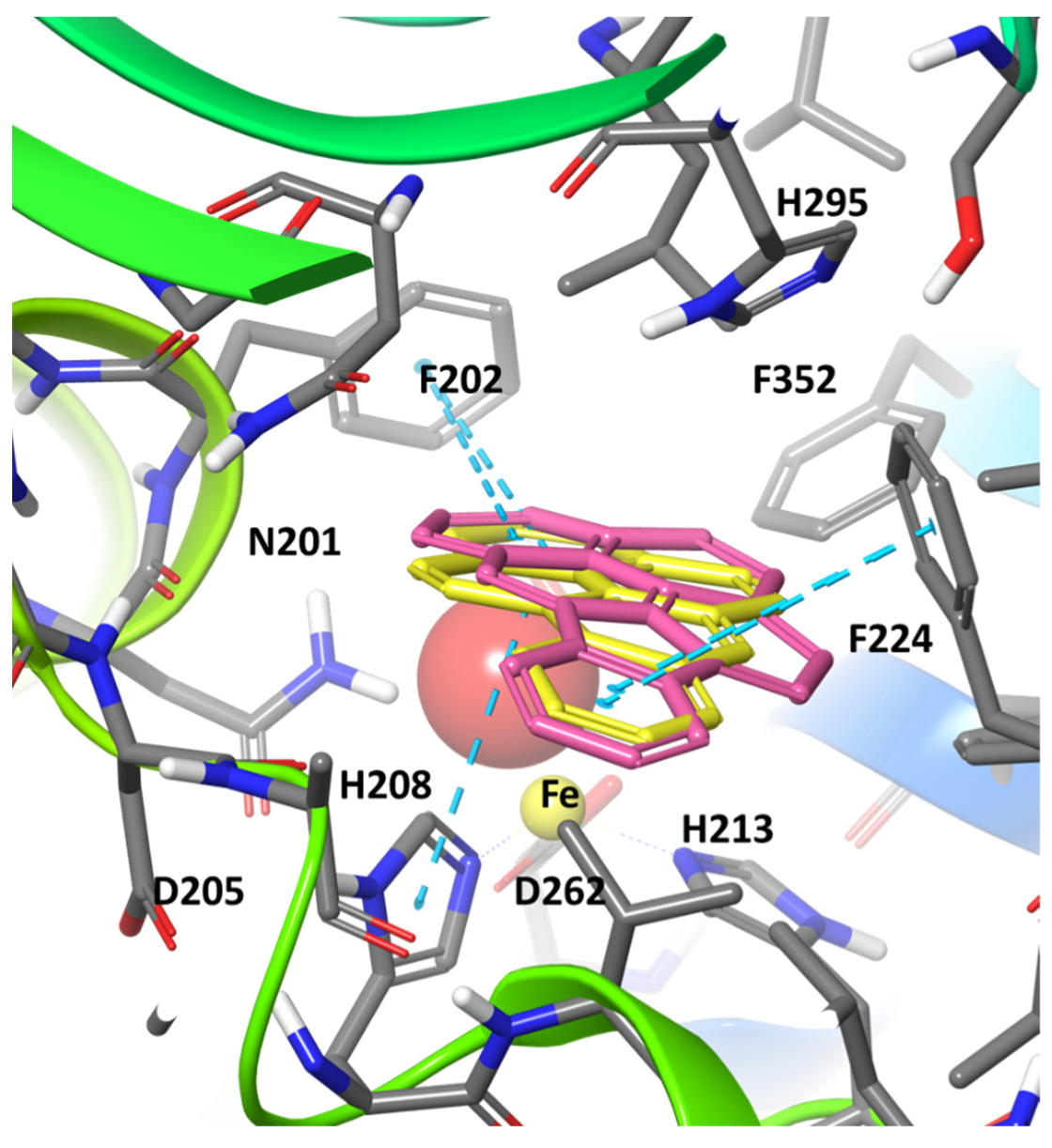Identification of New Dioxygenases Able to Recognize Polycyclic Aromatic Hydrocarbons with High Aromaticity
Abstract
1. Introduction
2. Results and Discussion
3. Materials and Methods
4. Conclusions
Supplementary Materials
Author Contributions
Funding
Conflicts of Interest
References
- Sahoo, B.M.; Ravi Kumar, B.V.V.; Banik, B.K.; Borah, P. Polyaromatic Hydrocarbons (PAHs): Structures, Synthesis and their Biological Profile. Curr. Org. Synth. 2020, 17, 625–640. [Google Scholar] [CrossRef]
- Patel, A.B.; Shaikh, S.; Jain, K.R.; Desai, C.; Madamwar, D. Polycyclic Aromatic Hydrocarbons: Sources, Toxicity, and Remediation Approaches. Front. Microbiol. 2020, 11, 1–23. [Google Scholar] [CrossRef] [PubMed]
- Abdel-Shafy, H.I.; Mansour, M.S.M. A review on polycyclic aromatic hydrocarbons: Source, environmental impact, effect on human health and remediation. Egypt. J. Pet. 2016, 25, 107–123. [Google Scholar] [CrossRef]
- Cerniglia, C.E. Biodegradation of polycyclic aromatic hydrocarbons. Biodegradation 1992, 3, 351–368. [Google Scholar] [CrossRef]
- Juhasz, A.L.; Naidu, R. Bioremediation of high molecular weight polycyclic aromatic hydrocarbons: A review of the microbial degradation of benzo[a]pyrene. Int. Biodeterior. Biodegrad. 2000, 45, 57–88. [Google Scholar] [CrossRef]
- Viñas, M.; Solanas, A. Biorremediación de Suelos Contaminados por Hidrocarburos: Caracterización Microbiológica, Química y Ecotoxicológica. Ph.D. Thesis, Universitat de Barcelona, Barcelona, Spain, 2005. [Google Scholar]
- Desai, A.M.; Autenrieth, R.L.; Dimitriou-Christidis, P.; McDonald, T.J. Biodegradation kinetics of select polycyclic aromatic hydrocarbon (PAH) mixtures by Sphingomonas paucimobilis EPA505. Biodegradation 2008, 19, 223–233. [Google Scholar] [CrossRef]
- Vaidya, S.; Devpura, N.; Jain, K.; Madamwar, D. Degradation of chrysene by enriched bacterial consortium. Front. Microbiol. 2018, 9, 1–14. [Google Scholar] [CrossRef]
- Rodríguez-gonzales, A.; Zárate-villarroel, S.G.; Bastida-codina, A. Biodiversidad Bacteriana Presente en Suelos Contaminados con Hidrocarburos Para Realizar Biorremediación; Universidad Nacional de Costa Rica: Heredia, Costa Rica, 2022; Volume 56, ISBN 0000000251419. [Google Scholar]
- Roszak, M.; Jabłó Nska, J.; Stachurska, X.; Dubrowska, K.; Kajdanowicz, J.; Goł˛ Ebiewska, M.; Kiepas-Kokot, A.; Osí Nska, B.; Augustyniak, A.; Karakulska, J. Development of an Autochthonous Microbial Consortium for Enhanced Bioremediation of PAH-Contaminated Soil. Int. J. Mol. Sci. Artic. 2021, 22, 13469. [Google Scholar] [CrossRef]
- Thomas, S.; Veettil, N.T.; Subbiah, K. Isolation, characterization and optimization of chrysene degradation using bacteria isolated from oil-contaminated water. Water Sci. Technol. 2021, 84, 2737–2748. [Google Scholar] [CrossRef]
- Morillo, E.; Madrid, F.; Lara-Moreno, A.; Villaverde, J. Soil bioremediation by cyclodextrins. A review. Int. J. Pharm. 2020, 591, 1–16. [Google Scholar] [CrossRef]
- Jouanneau, Y.; Meyer, C.; Duraffourg, N. Dihydroxylation of four- and five-ring aromatic hydrocarbons by the naphthalene dioxygenase from Sphingomonas CHY-1. Appl. Microbiol. Biotechnol. 2016, 100, 1253–1263. [Google Scholar] [CrossRef] [PubMed]
- Mutnuri, S.; Vasudevan, N.; Matthias, K. Degradation of anthracene and pyrene supplied by microcrystals and non-aqueous-phase liquids. Appl. Microbiol. Biotechnol. 2005, 67, 569–576. [Google Scholar] [CrossRef] [PubMed]
- Kanaly, R.A.; Harayama, S. Biodegradation of high-molecular-weight polycyclic aromatic hydrocarbons by bacteria. J. Bacteriol. 2000, 182, 2059–2067. [Google Scholar] [CrossRef] [PubMed]
- Jakoncic, J.; Jouanneau, Y.; Meyer, C.; Stojanoff, V. The catalytic pocket of the ring-hydroxylating dioxygenase from Sphingomonas CHY-1. Biochem. Biophys. Res. Commun. 2007, 352, 861–866. [Google Scholar] [CrossRef]
- Wackett, L.P. Mechanism and applications of Rieske non-heme iron dioxygenases. Enzym. Microb. Technol. 2002, 31, 577–587. [Google Scholar] [CrossRef]
- Boyd, D.R.; Sharma, N.D.; Brannigan, I.N.; McGivern, C.J.; Nockemann, P.; Stevenson, P.J.; McRoberts, C.; Hoering, P.; Allen, C.C.R. Cis-Dihydroxylation of Tricyclic Arenes and Heteroarenes Catalyzed by Toluene Dioxygenase: A Molecular Docking Study and Experimental Validation. Adv. Synth. Catal. 2019, 361, 2526–2537. [Google Scholar] [CrossRef]
- Kauppi, B.; Lee, K.; Carredano, E.; Parales, R.E.; Gibson, D.T.; Eklund, H.; Ramaswamy, S. Structure of an aromatic-ring-hydroxylating dioxygenasenaphthalene 1,2-dioxygenase. Structure 1998, 6, 571–586. [Google Scholar] [CrossRef]
- Mahto, J.K.; Neetu, N.; Waghmode, B.; Kuatsjah, E.; Sharma, M.; Sircar, D.; Sharma, A.K.; Tomar, S.; Eltis, L.D.; Kumar, P. Molecular insights into substrate recognition and catalysis by phthalate dioxygenase from Comamonas testosteroni. J. Biol. Chem. 2021, 297, 101416. [Google Scholar] [CrossRef]
- Ferraro, D.J.; Okerlund, A.L.; Mowers, J.C.; Ramaswamy, S. Structural basis for regioselectivity and stereoselectivity of product formation by naphthalene 1,2-dioxygenase. J. Bacteriol. 2006, 188, 6986–6994. [Google Scholar] [CrossRef][Green Version]
- Ferraro, D.J.; Gakhar, L.; Ramaswamy, S. Rieske business: Structure-function of Rieske non-heme oxygenases. Biochem. Biophys. Res. Commun. 2005, 338, 175–190. [Google Scholar] [CrossRef]
- Vila, M.A.; Umpiérrez, D.; Seoane, G.; Rodríguez, S.; Carrera, I.; Veiga, N. Computational insights into the oxidation of mono- and 1,4 disubstituted arenes by the Toluene Dioxygenase enzymatic complex. J. Mol. Catal. B Enzym. 2016, 133, S410–S419. [Google Scholar] [CrossRef]
- Jouanneau, Y.; Micoud, J.; Meyer, C. Purification and characterization of a three-component salicylate 1-hydroxylase from Sphingomonas sp. strain CHY-1. Appl. Environ. Microbiol. 2007, 73, 7515–7521. [Google Scholar] [CrossRef] [PubMed]
- Schuler, L.; Jouanneau, Y.; Ní Chadhain, S.M.; Meyer, C.; Pouli, M.; Zylstra, G.J.; Hols, P.; Agathos, S.N. Characterization of a ring-hydroxylating dioxygenase from phenanthrene-degrading Sphingomonas sp. strain LH128 able to oxidize benz[a]anthracene. Appl. Microbiol. Biotechnol. 2009, 83, 465–475. [Google Scholar] [CrossRef] [PubMed]
- Goris, J.; De Vos, P.; Caballero-Mellado, J.; Park, J.; Falsen, E.; Quensen, J.F.; Tiedje, J.M.; Vandamme, P. Classification of the biphenyl- and polychlorinated biphenyl-degrading strain LB400T and relatives as Burkholderia xenovorans sp. nov. Int. J. Syst. Evol. Microbiol. 2004, 54, 1677–1681. [Google Scholar] [CrossRef]
- Auffret, M.; Labbé, D.; Thouand, G.; Greer, C.W.; Fayolle-Guichard, F. Degradation of a mixture of hydrocarbons, gasoline, and diesel oil additives by Rhodococcus aetherivorans and Rhodococcus wratislaviensis. Appl. Environ. Microbiol. 2009, 75, 7774–7782. [Google Scholar] [CrossRef] [PubMed]
- Olowomofe, T.O.; Oluyege, J.O.; Aderiye, B.I.; Oluwole, O.A. Degradation of poly aromatic fractions of crude oil and detection of catabolic genes in hydrocarbon-degrading bacteria isolated from Agbabu bitumen sediments in Ondo State. AIMS Microbiol. 2019, 5, 308–323. [Google Scholar] [CrossRef]
- Labute, P. Protonate3D: Assignment of ionization states and hydrogen coordinates to macromolecular structures. Proteins Struct. Funct. Bioinform. 2009, 75, 187–205. [Google Scholar] [CrossRef]
- Madhavi Sastry, G.; Adzhigirey, M.; Day, T.; Annabhimoju, R.; Sherman, W. Protein and ligand preparation: Parameters, protocols, and influence on virtual screening enrichments. J. Comput. Aided. Mol. Des. 2013, 27, 221–234. [Google Scholar] [CrossRef]
- Friesner, R.A.; Murphy, R.B.; Repasky, M.P.; Frye, L.L.; Greenwood, J.R.; Halgren, T.A.; Sanschagrin, P.C.; Mainz, D.T. Extra precision glide: Docking and scoring incorporating a model of hydrophobic enclosure for protein-ligand complexes. J. Med. Chem. 2006, 49, 6177–6196. [Google Scholar] [CrossRef]
- Warren, G.L.; Andrews, C.W.; Capelli, A.M.; Clarke, B.; LaLonde, J.; Lambert, M.H.; Lindvall, M.; Nevins, N.; Semus, S.F.; Senger, S.; et al. A critical assessment of docking programs and scoring functions. J. Med. Chem. 2006, 49, 5912–5931. [Google Scholar] [CrossRef]







| Code (PDB) | Organism | Dioxygenase/ Uniprot No. | Ions/Ligand |
|---|---|---|---|
| 2ckf 2gbw 2gbx 2i7f | Sphingomonas sp. CHY-1 (Gram+) Sphingobium yanoikuyae (Gram+) | Naphthalene 1,2- Q65AT1 Biphenyl 2,3- /A2TC87 | Fe2S2, Fe3+ ---- Biphenyl |
| 2b1x 2b24 | Rhodococcus sp. NCIMB 12038 (Gram-) | Naphthalene Q9 × 3r9 | Fe2S2, Fe3+ Indol |
| 1ulj 1uli | Rhodococcus jostii RHA1 (Gram-) | Biphenyl 2,3 | Fe2S2, Fe3+ Biphenyl |
| 1eg9 1ndo 1o7n 1o7p 3en1 3eqq | Pseudomonas putida (Gram-) | Naphthalene 1,2 P0A110 Toluene 2,3-/A5W4F2 | Fe2S2, Fe3+, SO4− Indole Toluene ---- |
| 4hjl + 4hkv | Pseudomonas sp. C18 (Gram-) | Naphthalene 1,2-/P0A111 | Fe2S2, Fe3+, SO4− Naphthalene Benzamide |
| 2xsh 2xrx 2xso 2xsh | Paraburkholderia xenovorans LB400 (Gram-) | Biphenyl/ P37,334 | Fe2S2, Fe3+, SO4− Biphenyl --- |
Publisher’s Note: MDPI stays neutral with regard to jurisdictional claims in published maps and institutional affiliations. |
© 2022 by the authors. Licensee MDPI, Basel, Switzerland. This article is an open access article distributed under the terms and conditions of the Creative Commons Attribution (CC BY) license (https://creativecommons.org/licenses/by/4.0/).
Share and Cite
Rodríguez, A.; Zárate, S.G.; Bastida, A. Identification of New Dioxygenases Able to Recognize Polycyclic Aromatic Hydrocarbons with High Aromaticity. Catalysts 2022, 12, 279. https://doi.org/10.3390/catal12030279
Rodríguez A, Zárate SG, Bastida A. Identification of New Dioxygenases Able to Recognize Polycyclic Aromatic Hydrocarbons with High Aromaticity. Catalysts. 2022; 12(3):279. https://doi.org/10.3390/catal12030279
Chicago/Turabian StyleRodríguez, Apolonia, Sandra G. Zárate, and Agatha Bastida. 2022. "Identification of New Dioxygenases Able to Recognize Polycyclic Aromatic Hydrocarbons with High Aromaticity" Catalysts 12, no. 3: 279. https://doi.org/10.3390/catal12030279
APA StyleRodríguez, A., Zárate, S. G., & Bastida, A. (2022). Identification of New Dioxygenases Able to Recognize Polycyclic Aromatic Hydrocarbons with High Aromaticity. Catalysts, 12(3), 279. https://doi.org/10.3390/catal12030279







